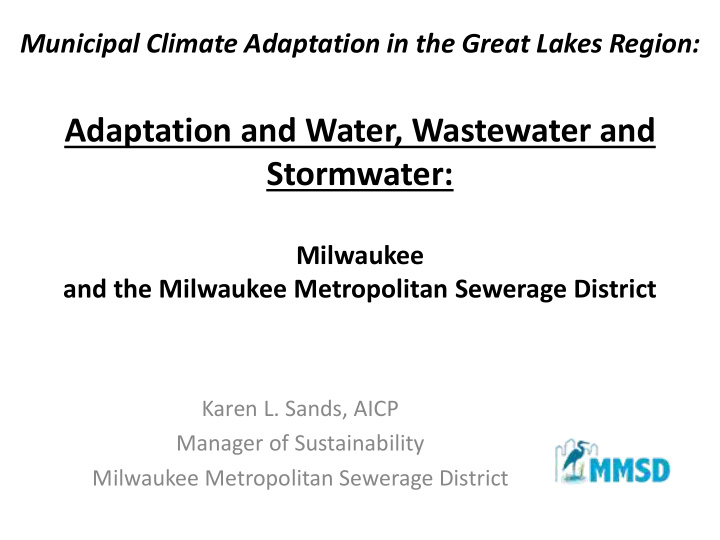



Municipal Climate Adaptation in the Great Lakes Region: Adaptation and Water, Wastewater and Stormwater: Milwaukee and the Milwaukee Metropolitan Sewerage District Karen L. Sands, AICP Manager of Sustainability Milwaukee Metropolitan Sewerage District
Today’s Talk… • Brief MMSD Background • Climate Change Context • Adaptation 1/29/2015
Milwaukee Metropolitan Sewerage District We Serve: • 1.1 Million Customers • 28 Municipalities • 411 Square Miles Using Grey Infrastructure: • Collector Sewers • 2 Water Reclamation Facilities • 521 MG Tunnel Storage To Protect the Environment: • Convey/Store/Reclaim Wastewater • Manage Flooding • Much More… 1/29/2015
End Result! 1/29/2015
Regional Climate Change Context: WICCI
Climate Change Data Climate Change: Data Speaks for Itself Kinnickinnic River top 5 crests: (1) 16.01 ft on 08/06/1986 (2) 13.29 ft on 06/08/ 2008 (3) 13.22 ft on 07/10/ 2006 (4) 13.20 ft on 07/15/ 2010 (5) 13.17 ft on 07/23/ 2010 1/29/2015
MMSD’s 2035 Vision and Strategic Objectives Broad Strategic Objectives For: 1. Integrated Watershed Management 2. Climate Change Mitigation/Adaptation with an Emphasis on Energy Efficiency 1/29/2015
MMSD’s Overall Climate Change Strategy
Climate Change Issues for MMSD • More frequent large storms • Longer drought periods in between storms • More precipitation falling on frozen ground • Others…
MMSD Adaptation Solutions • Flood management • Green infrastructure to infiltrate, hold, evapotranspire • Vulnerability analysis
Flood Management: Lincoln Creek Befor ore After ter • Concrete removal to naturalize channel • Minimized floodplain • Habitat enhancement 1/29/2015
MMSD’s Plan: What’s So Groundbreaking? • 0.5” of rainfall on imperviousness = 740 MG! • Emphasizes combined & separate sewer service areas • Supports private property inflow & infiltration • Promotes turf grass with soil amendments • Assumes we support but d on’t directly build
Milwaukee’s Refresh and GI Baseline Inventory (GIBI) Reports • Recommends an annual 10% volume increase • Current implementation: 8 MG • Additional designed/funded: 19.5 MG • Report is an inventory only, does not establish GI targets
MMSD’s On -Going Programs
Climate Change Vulnerability Analysis
Identify High, Medium and Low Risks, Then… Adapt: • Take no-regrets actions, like: – Maximize onsite-generated power for ISS pumps – Consider sewer lining materials resistant to H2S – Maximize implementation of GI practices • Take actions to address climate change
For Instance… • Falling lake levels dry foundation piles
Next Steps (besides GI) • Monitor floodplains • Evaluate feasibility of modifications – MIS pump stations, change to gravity sewers – Retrofit electronic equipment with ventilation – Replace WRF equipment to reduce costs • Develop vector management plan • Review rain data for changes in volumes and frequency
MMSD Mitigation (besides adaptation) • Renewable energy/ energy conservation • GI to sequester carbon • Carbon footprint
Karen Sands, AICP Milwaukee Metropolitan Sewerage District ksands@mmsd.com 414-225-2123 www.mmsd.com www.h2ocapture.com
Recommend
More recommend